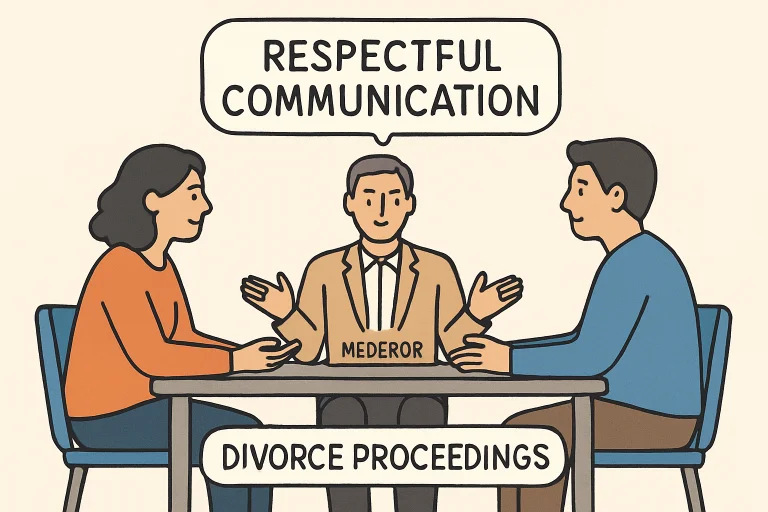Effective Communication Strategies During Divorce Proceedings
Key Takeaways
- Establish clear communication boundaries to prevent conflicts and misunderstandings.
- Use I statements to express yourself without sounding accusatory or confrontational.
- Focus on collaborative problem solving rather than rehashing old grievances.
- Practice active listening to ensure both voices are heard and valued.
- Center communication around the needs and well being of any children involved.
Table of Contents
- Introduction
- Establishing Clear Communication Boundaries
- Utilizing I Statements
- Focusing on Problem Solving
- Practicing Active Listening
- Prioritizing Childrens Well Being
- Benefits of Healthy Communication
- Seeking Professional Assistance
Divorce can be one of the most emotionally taxing experiences of a persons life, marked by tough decisions, shifting family dynamics, and uncertainty about the future. Navigating these waters becomes even more difficult when communication between separating spouses breaks down. Learning to communicate effectively and respectfully during divorce proceedings is crucial not only to reach equitable agreements, but also to minimize harm to all parties involved. For couples facing legal separation in Texas, understanding the reasons for divorce in Texas is a necessary starting point to begin these conversations from a place of clarity rather than conflict. Healthy communication is not simply about saying the right words; its about establishing boundaries, being mindful of the emotional climate, and moving forward constructively. By focusing on cooperation and mutual respect, couples can avoid unnecessary escalation and chart a smoother route through an inherently turbulent process. Implementing effective strategies at this stage isnt just about the present it lays the groundwork for future interactions, especially if children are involved.
Every divorce is unique, yet the tools for effective communication remain universally beneficial. Embracing change with pragmatic optimism will only work if both parties invest in open dialogue and prioritize their familys well being over personal disputes. Taking these steps can ease the transition out of marriage and help preserve your mental health, dignity, and resources when clarity is needed the most. Experts emphasize that healthy discussions frequently lead to better outcomes: fostering cooperation, accelerating the legal process, and reducing legal costs. Families who prioritize calm communication during divorce are more likely to maintain positive coparenting relationships post separation. If you wish to further explore best practices for communicating under stress, the Mayo Clinic offers evidence based strategies for managing difficult conversations in tense times.
Establishing Clear Communication Boundaries
Setting enforceable boundaries early on can prevent escalations and keep discussions focused. Begin by mutually agreeing to communicate respectfully: avoid shouting or using personal insults, and agree to pause conversations when emotions become too intense. This not only de escalates tension but also models positive behavior for children who may be observing. Clearly defining what will and wont be discussed in each conversation helps both parties stay present and work towards specific objectives. Mediation can be particularly beneficial during this stage. A trained mediator can ensure each party has a fair chance to express their needs without being interrupted or undermined. This structured environment often leads to more civil and productive exchanges, especially for couples struggling with longstanding grievances. Consider the following additional tips from Psychology Today for navigating major transitions.
Utilizing I Statements
Adopting I statements shifts the narrative from blame to self reflection, making it less likely for discussions to devolve into defensiveness. Communicating your feelings from your own perspective, such as I feel worried about our childrens routine instead of You never care about their needs, can open the door for constructive responses rather than escalation. Consistently using I statements throughout divorce proceedings enables both parties to speak candidly without triggering defensive reactions that disrupt progress. This simple yet profound shift in language can foster compromise, even when emotions are running high.
Focusing on Problem Solving
Rather than getting stuck in the cycle of rehashing past grievances, successful coparenting and equitable division of assets depend on future oriented conversations. A problem mindset encourages both parties to collaboratively brainstorm solutions, weigh the pros and cons, and strive for agreements that reflect mutual interests whether thats developing a new custody schedule or negotiating property division.
Mediation offers a practical framework for these solution driven conversations. Instead of adversarial courtroom confrontations, couples work together to identify shared priorities, decreasing the likelihood of long term resentment.
Practicing Active Listening
Active listening is critical for understanding your former partners concerns and avoiding misinterpretation. Effective active listening means giving your full attention, maintaining open body language, and summarizing or reflecting back what youve heard before responding. This approach not only diffuses tension but also signals respect, which can be pivotal in emotionally charged moments. Asking clarifying questions and resisting the urge to immediately counter argue ensures that both parties are genuinely understood. Taking notes, maintaining eye contact, and minimizing interruptions are powerful ways to keep the process moving forward amicably.
Prioritizing Childrens Well Being
When children are involved, their emotional and psychological needs must always come first. Establishing a cooperative coparenting plan, speaking respectfully about the other parent, and shielding children from adult disputes are essential best practices for maintaining a healthy relationship. Children benefit most from seeing their parents act civilly, even in difficult moments, as this provides them with a sense of stability and security thats crucial during periods of change. Coparenting platforms and family therapists can offer invaluable guidance, helping both parents align on critical decisions and prioritize their childrens best interests. The American Academy of Pediatrics offers resources and research to help parents ensure that their children navigate the divorce process as smoothly as possible.
Benefits of Healthy Communication
- Reduced Stress: Open, boundary based communication helps decrease the emotional strain associated with the divorce process.
- Quicker Resolutions: Disputes are less likely to stall or escalate into court battles, allowing for efficient resolution.
- Lower Costs: Avoids expensive and drawn out legal conflicts.
- Better Outcomes for Kids: Children experience fewer negative effects, and parents establish a solid foundation for future cooperation.
- Increased Control: By working together, both parties have more influence over the terms of their separation.
Seeking Professional Assistance
Sometimes, conversations become too overwhelming to handle on ones own. In these cases, consider enlisting professional support a neutral mediator, family therapist, or experienced divorce attorney can create opportunities for productive dialogue and safeguard your interests. Not only can professionals help manage high emotion interactions, but they can also introduce tools and strategies to prevent recurring conflicts.
Remember, the support you seek today can help you navigate a healthier journey through divorce and set you on a path toward resilience and a more peaceful future.




